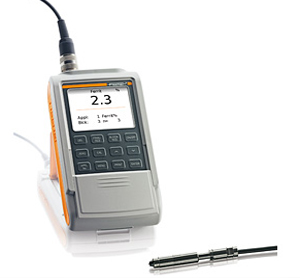- Home
- About Us
- Inspection Services
- Conventional Non-Destructive Testing
- Ultrasonic Weld Scan
- Ultrasonic Thickness Gauging
- Eddy Current Testing
- Radiography Testing
- Liquid Penetrant Testing
- View More

Austenitic, Duplex, Super-duplex stainless steels require adequate proportion of ferrite in the product to obtain acceptable corrosion resistance and strength and especially resistance to Stress Corrosion Cracking (SCC).
The laboratory-based destructive method such as microstructural analysis on the test specimen or sample obtained from the batch of the product or components provides statistical quality assurance. In order to guarantee the acceptable ferrite content in the final product, ferrite measurements are performed on the actual product. Ferrite measurement using Ferritoscope is a non-destructive test method which assures the quality of the product without the need of expensive laboratory-based destructive test methods.
Use of acid-resistant steel and in particular acid-resistant clad steel creates a series of problems of technological and metallurgical nature. During welding of acid-resistant homogenous steel of purely austenitic structure with clad steel, the base of which is of ferritic-pearlitic structure, mixing of acid-resistant weld metal of autsetnitic structure with low-carbon weld metal of ferritic-pearlitic structure takes place. The applied technology and selection of welding materials should guarantee such joint, where the ferrite content in the weld ranges from 2 up to 8% with manual welding and up to 10% with automatic welding.
The test requires only a light contact which leaves no mark.
Ferrite values are determined directly and quickly.
Highly portable digital technology
Testing instrument meets all requirements of ANSI/AWS A4.2 and DIN EN ISO 8249.
Calibration is traceable to internationally approved IIW secondary calibration standards.
Variable calibration in both Ferrite Number (FN) and % Ferrite (FN) using AWS Standards.